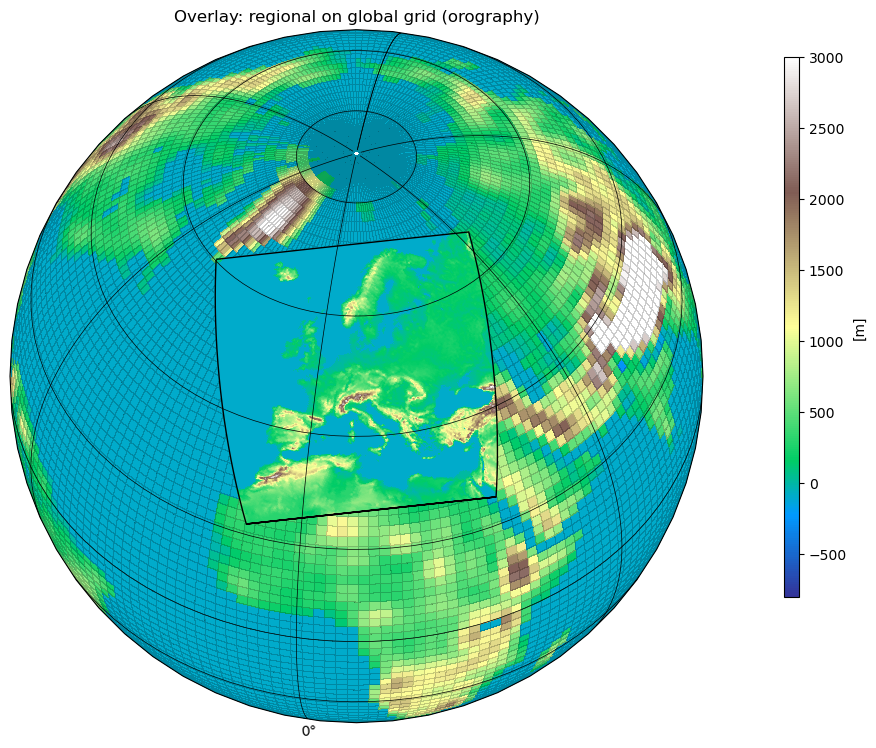Python overlay regional on global grid#
Software requirements:
Python 3
Numpy
matplotlib
cartopy
xarray
Projection: - Orthographic
Grids:
The first grid is a coarse global grid (CMIP5)
grid type: lonlat
points=18432 (192x96)
lon : 0 to 358.125 by 1.875 degrees_east circular
lat : -88.57217 to 88.57217 degrees_north
The second grid is a high resolution regional grid (CORDEX EUR-11)
grid type: curvilinear
points=174688 (424x412)
lon : -44.59386 to 64.96438 degrees_east
lat : 21.98783 to 72.585 degrees_north
Example script#
overlay_regional_on_global_grid.py
#!/usr/bin/env python
# coding: utf-8
'''
DKRZ example
Draw two grids with different resolutions
Used packages:
- numpy
- xarray
- matplotlib
- cartopy
Projection:
- Orthographic
Grids:
1. The first grid is a coarse global grid (CMIP5)
grid type: lonlat
points=18432 (192x96)
lon : 0 to 358.125 by 1.875 degrees_east circular
lat : -88.57217 to 88.57217 degrees_north
2. The second grid is a high resolution regional grid (CORDEX EUR-11)
grid type: curvilinear
points=174688 (424x412)
lon : -44.59386 to 64.96438 degrees_east
lat : 21.98783 to 72.585 degrees_north
-------------------------------------------------------------------------------
2021 copyright DKRZ licensed under CC BY-NC-SA 4.0 <br>
(https://creativecommons.org/licenses/by-nc-sa/4.0/deed.en)
-------------------------------------------------------------------------------
'''
import numpy as np
import xarray as xr
import cartopy.crs as ccrs
import cartopy.feature as cfeature
import cartopy.util as cutil
import matplotlib.pyplot as plt
import matplotlib.patches as mpatches
def main():
#-- Read global data:
orog_file1 = "../../data/orog_fx_MPI-ESM-LR_rcp26_r0i0p0.nc" #-- orography
laf_file1 = "../../data/sftlf_fx_MPI-ESM-LR_rcp26_r0i0p0.nc" #-- land area fraction
#-- open file and read variables
f1 = xr.open_dataset(orog_file1)
var1 = f1.orog
mask1 = xr.open_dataset(laf_file1)
lsm1 = mask1.sftlf
lsm1 = np.where(lsm1 > 0.5, lsm1, 0)
land_only1 = np.where(lsm1 > 0.5, var1, -101) #-- min contour value - 1
lat = f1.lat
lon = f1.lon
dlat = lat[1]-lat[0]
dlon = lon[1]-lon[0]
#-- Add cyclic points:
cyclic_data, cyclic_lon = cutil.add_cyclic_point(land_only1, coord=lon)
#-- Read regional data:
orog_file2 = "../../data/orog_EUR-11_MPI-M-MPI-ESM-LR_historical_r0i0p0_CLMcom-CCLM4-8-17_v1_fx.nc"
laf_file2 = "../../data/sftlf_EUR-11_MPI-M-MPI-ESM-LR_historical_r0i0p0_CLMcom-CCLM4-8-17_v1_fx.nc"
f2 = xr.open_dataset(orog_file2)
var2 = f2.orog
mask2 = xr.open_dataset(laf_file2)
lsm2 = mask2.sftlf
lsm2 = np.where(lsm2 > 0.5, lsm2, 0)
land_only2 = np.where(lsm2 > 0.5, var2, -101) #-- min contour value - 1
lat2d = f2.lat
lon2d = f2.lon
nlat = len(lat2d[:,0])
nlon = len(lon2d[0,:])
#-- Define edges of regional data:
lon_val_lower = lon2d[0,:]
lon_val_right = lon2d[:,nlon-1]
lon_val_left = lon2d[:,0]
lon_val_upper = lon2d[nlat-1,:]
lat_val_lower = lat2d[0,:]
lat_val_right = lat2d[:,nlon-1]
lat_val_left = lat2d[:,0]
lat_val_upper = lat2d[nlat-1,:]
#-- Generate the data for the edges of the regional grid
line_lons = np.append([lon_val_upper], [lon_val_right[::-1]])
line_lons = np.append([line_lons], [lon_val_lower])
line_lons = np.append([line_lons], [lon_val_left])
line_lats = np.append([lat_val_upper], [lat_val_right[::-1]])
line_lats = np.append([line_lats], [lat_val_lower])
line_lats = np.append([line_lats], [lat_val_left])
polyline = np.column_stack([line_lons, line_lats])
#-- Create the color mesh plot:
projection=ccrs.Orthographic(central_latitude=50.0, central_longitude=10.0)
plt.switch_backend('agg')
fig, ax = plt.subplots(figsize=(10,9), subplot_kw=dict(projection=projection))
ax.set_global()
#-- add coastlines and grid lines
ax.add_feature(cfeature.COASTLINE.with_scale('50m'), linewidth=0.5)
gl = ax.gridlines(draw_labels=True, linewidth=0.5, color='k', zorder=3)
gl.xlabel_style = {'size':10}
gl.ylabel_style = {'size':10}
gl.top_labels = True
gl.right_labels = True
#-- plot the title string
plt.title('Overlay: regional on global grid (orography)')
#-- define color map
cmap = 'terrain'
#-- create the color mesh plot
edgecolor = [0.0, 0.0, 0.0, 0.2] #'k'
linewidth = 0.005
cnf1 = ax.pcolormesh(cyclic_lon, lat, cyclic_data,
cmap=cmap,
vmin=-800,
vmax=3000,
edgecolor=edgecolor,
linewidth=linewidth,
transform=ccrs.PlateCarree())
cnf2 = ax.pcolormesh(lon2d, lat2d, land_only2,
cmap=cmap,
vmin=-800,
vmax=3000,
transform=ccrs.PlateCarree())
#-- add a polyline around the regional grid
lw, ec, fc = 1, 'k', 'y' #-- linewidth, edgecolor, facecolor
ax.add_patch(mpatches.Polygon(polyline,
closed=False,
fill=False,
linewidth=lw,
edgecolor=ec,
facecolor=fc,
transform=ccrs.Geodetic()))
#-- add a color bar
cbar_ax = fig.add_axes([0.94, 0.25, 0.015, 0.6], autoscalex_on=True) #-- x,y,w,h
cbar = fig.colorbar(cnf1, cax=cbar_ax, orientation='vertical')
plt.setp(cbar.ax.get_xticklabels()[::2], visible=False)
cbar.set_label('[m]')
#-- save the plot in PNG format
plt.savefig('plot_grid_resolutions_overlay.png', bbox_inches='tight', dpi=100)
if __name__ == '__main__':
main()
